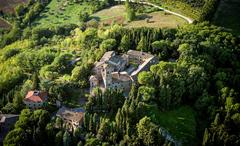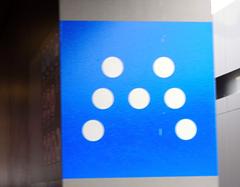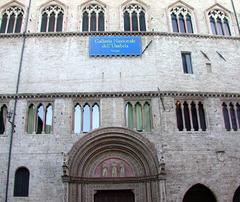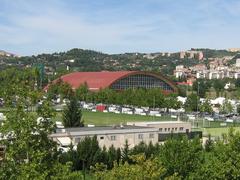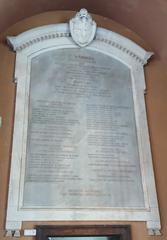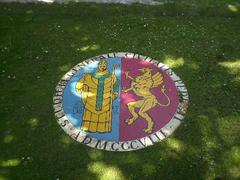
Collegio del Cambio Perugia: Visiting Hours, Tickets, and Historical Significance
Date: 04/07/2025
Introduction
Located in the heart of Perugia, Italy, the Collegio del Cambio stands as a testament to the city’s rich medieval and Renaissance legacy. Once the guild hall of Perugia’s powerful money changers, the Collegio is celebrated today for its artistic treasures, especially the celebrated frescoes by Pietro Perugino. This comprehensive guide covers everything you need to know for your visit, including historical context, practical visitor information, accessibility, and travel tips—ensuring you experience one of Perugia’s most remarkable cultural landmarks to the fullest.
For the latest updates and details, consult the official Collegio del Cambio website, or refer to trusted resources such as PlanetWare and WhichMuseum.
Table of Contents
- Introduction
- Historical Background
- Visitor Information
- What to See: Artistic and Architectural Highlights
- Practical Travel Tips
- Nearby Attractions
- Frequently Asked Questions (FAQ)
- Conclusion
- References
Historical Background
Origins and Foundation
The Collegio del Cambio, established in the early 14th century, served as the headquarters for Perugia’s money changers—a vital profession in the city’s thriving trade economy. The guild’s statutes date back to 1326, and by 1361, their growing influence secured a permanent presence close to the Duomo (Key to Umbria). In 1428, Pope Martin V granted the guild the use of a former monastery on Corso Vannucci, which soon became their permanent headquarters (Traveling in Tuscany).
The Guild System and Palazzo dei Priori
Perugia was home to a sophisticated guild system—at its peak, 44 guilds shaped the city’s economic and civic life (LawArt). The Collegio del Cambio was second in prominence only to the Merchants’ Guild, and its members—typically wealthy citizens—played pivotal roles not only in commerce but also in the administration of justice and charitable activities (Collegio del Cambio Official Site).
The guild’s elegant headquarters sit within the Palazzo dei Priori, an iconic example of Gothic civic architecture constructed between 1292 and 1443 (LawArt). The Collegio occupies three principal rooms:
- Sala dei Legisti: Features intricate 17th-century wood inlay by Giampietro Zuccari.
- Sala dell’Udienza: Italy’s best-preserved 15th-century secular chamber, renowned for Perugino’s frescoes.
- Chapel of St. John the Baptist: Reflects the guild’s religious commitments (Traveling in Tuscany).
Perugino’s Renaissance Masterpiece
Between 1496 and 1500, Pietro Perugino transformed the Sala dell’Udienza with a cycle of frescoes that blend classical heroes, biblical figures, and allegories of virtue, including his own self-portrait (Collegio del Cambio Official Site, LawArt). These masterpieces are celebrated for their serene composition, luminous colors, and embodiment of Renaissance humanist ideals (PlanetWare).
Visitor Information
Visiting Hours and Admission
- Hours:
The Collegio del Cambio is generally open daily from 9:00 AM to 1:00 PM and 2:30 PM to 5:30 PM. From November 2nd to March 31st, it closes on Monday afternoons. The museum is closed on December 25th and January 1st (Official Collegio del Cambio Website). Always check the official site or call +39 075 9372110 to confirm current hours. - Tickets:
Standard admission is €4.50 per adult (Nomads Travel Guide). Combined tickets with the Nobile Collegio della Mercanzia are available for a broader experience of Perugia’s guild history. Discounts are offered for students, seniors, and groups. Children under a certain age may enter free (WhichMuseum). - How to Purchase:
Tickets can be purchased onsite or online via the official website. Advance booking is recommended during festivals or peak tourist seasons.
Accessibility
The Collegio del Cambio offers assistance for visitors with mobility challenges, making its three main rooms accessible (Official Site). However, as a historic building, some architectural barriers remain. Pushchairs are allowed, but facilities such as restrooms and cloakrooms are limited.
Photography
Photography is generally prohibited inside the museum to preserve the delicate artworks. Flash photography and video recording are not allowed. Visitors are also asked to refrain from eating, drinking, or using mobile phones within exhibition spaces.
Guided Tours and Digital Resources
Guided tours provide valuable insights into the art and history of the site. The “Perugia of Perugino” card may include guided visits and access to other museums (Official Site). Advance booking is strongly advised, especially during busy periods.
For self-guided tours, the MaPp - MuseiAppPerugia app offers digital resources and virtual tours.
What to See: Artistic and Architectural Highlights
- Sala delle Udienze (Audience Hall):
Marvel at Perugino’s renowned frescoes depicting civic virtues, biblical narratives, and classical mythology. Look for Perugino’s self-portrait on one of the pillars (Umbria Tourism). - Sala dei Legisti:
The entrance hall, adorned with 1615 woodwork by Giampietro Zuccari, originally served the legal guild (Summer in Italy). - Chapel of St. John the Baptist:
Decorated with frescoes by Giannicola di Paolo, a disciple of Perugino (Umbria Tourism). - Monetary Weights Collection:
Over 550 weights dating from the 15th to 19th centuries recount Perugia’s economic history (WhichMuseum).
Take your time to appreciate the vibrant colors, allegorical imagery, and exceptional preservation of these Renaissance masterpieces.
Practical Travel Tips
- Best Time to Visit:
Spring (April–June) and early autumn (September) feature mild weather and fewer tourists (Eupedia). Arriving early in the morning or late afternoon helps avoid crowds (TripHobo). - Visit Duration:
Allocate about one hour to explore; art lovers may wish to linger longer. - Dress Code:
Modest clothing is appreciated, especially when entering the chapel. - Language:
Most on-site information is in Italian; consider a guide or app for English explanations. - Nearby Amenities:
Corso Vannucci offers cafés, restaurants, and shops for a relaxing break before or after your visit. - Getting There:
The museum is situated at Corso Vannucci, 25, 06121 Perugia (Official Site). Parking is limited in the historic center; use public parking lots and the Minimetrò shuttle service.
Nearby Attractions
- Galleria Nazionale dell’Umbria:
A premier collection of Umbrian Renaissance art, located in the same Palazzo dei Priori. - Sala dei Notari:
Another stunning civic chamber with frescoes. - Perugia Cathedral and Fontana Maggiore:
Both are a short walk away and offer further immersion in Perugia’s rich past.
Frequently Asked Questions (FAQ)
Q: What are the Collegio del Cambio visiting hours?
A: Generally, 9:00 AM–1:00 PM and 2:30 PM–5:30 PM. Closed Monday afternoons in winter and on December 25th and January 1st. Always verify before visiting.
Q: How much do tickets cost?
A: €4.50 per adult, with discounts for students, seniors, and groups. Combined tickets are available.
Q: Can I take photos inside?
A: No, photography is generally prohibited to protect the artworks.
Q: Is the museum accessible for visitors with mobility challenges?
A: Yes, with assistance, the main rooms are accessible though some barriers persist.
Q: Are guided tours available?
A: Yes, guided tours and the “Perugia of Perugino” card are offered. Advance booking is recommended.
Conclusion
The Collegio del Cambio is a must-see for visitors to Perugia, offering an unparalleled glimpse into the city’s artistic, civic, and economic history. Its magnificent Renaissance frescoes, exceptional woodwork, and prime location within the Palazzo dei Priori make it one of Italy’s hidden gems. Plan your visit in advance, consider a guided tour, and explore nearby attractions for a full appreciation of Perugia’s cultural heritage.
For the latest details and to plan your trip, visit the official website, and consider downloading the Audiala app for self-guided tours and insider tips.
References
- Visiting the Collegio del Cambio in Perugia: History, Tickets, and Tips, 2025, Key to Umbria (https://keytoumbria.com/Perugia/Collegio_del_Cambio.html)
- Visiting the Collegio del Cambio in Perugia: History, Tickets, and Tips, 2025, LawArt (https://www.lawart.it/Article/Archive/index_html?ida=54&idn=3&idi=-1&idu=-1)
- Visiting the Collegio del Cambio in Perugia: History, Tickets, and Tips, 2025, Traveling in Tuscany (http://www.travelingintuscany.com/art/perugino/collegiodelcambio.htm)
- Visiting the Collegio del Cambio in Perugia: Hours, Tickets, History, and Art, 2025, PlanetWare (https://www.planetware.com/tourist-attractions-/perugia-i-um-pe.htm)
- Visiting the Collegio del Cambio in Perugia: Hours, Tickets, History, and Art, 2025, NextStop Italy (https://nextstop-italy.com/virtual-tours/noble-collage-cambio/)
- Collegio del Cambio Visiting Hours, Tickets, and Guide to Perugia’s Historical Gem, 2025, Touropia (https://www.touropia.com/things-to-do-in-perugia-italy/)
- Collegio del Cambio Visiting Hours, Tickets, and Guide to Perugia’s Historical Gem, 2025, WhichMuseum (https://whichmuseum.com/museum/collegio-del-cambio-perugia-38634/opening-hours)
- Collegio del Cambio Visiting Hours, Tickets & Tips: Your Guide to Perugia’s Historic Gem, 2025, Official Collegio del Cambio Website (https://www.collegiodelcambio.it/en/info-and-contacts/)
- Collegio del Cambio Visiting Hours & Tips, 2025, Nomads Travel Guide (https://www.nomads-travel-guide.com/places/nobile-collegio-del-cambio/)
- Best Time To Visit Perugia, 2025, Best Time To Visit (https://best-time.to/visit/perugia/)
- Eupedia, 2025, Perugia Travel Guide (https://www.eupedia.com/italy/perugia.shtml)

